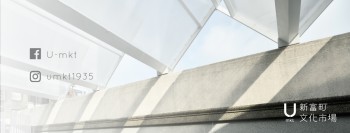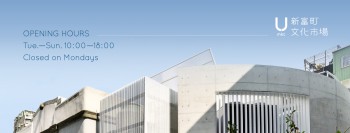Déjà vu: Re-Envisioning Market&Place
About the Exhibition
The ups and downs of the Xinfu Market over the past 84 years not only bear testimony to the changes in environment texture and lifestyle in Monga, but also epitomize the spirit of traditional markets in the course of time. No sooner did the JUT Land Development acquire a 9-year right of management of this market, than it commissioned the JUT Foundation for Arts and Architecture to run this place. Renamed the U-mkt and opened to the public again in March 2017, this place was repurposed for a public venue dedicated to perpetuating local knowledge, preserving traditional market culture, and igniting people’s imagination about life. By dint of appropriate measures for cultural assets revitalization and operational mechanism redesign, the U-mkt is expected to be a new catalyst for the transformation of the ancient city Monga.
To promote a more progressive and sustainable public meaning of the U-mkt, the JUT Foundation for Arts and Architecture has channeled the fruitful results of its previous field surveys and face-to-face interviews to run this place, for which it employs a multi-pronged strategy comprising thematic exhibitions, mutual learning courses, publishing, artist-in-residency, and market empowerment. It is noteworthy that its annual thematic exhibition gives prominence to site-specific creations, whereby homegrown discourses can be formulated and future scenarios of all stripes can be outlined. Titled Déjà vu: Re-Envisioning Market/Place and organized in collaboration with the ArchiBlur Lab known for its artistic collection and landscape architecture, this exhibition not only extends its field survey to the U-mkt’s surrounding areas, but also probes into the dialogical relations among place, architecture and body.
The phrase “Re-Envisioning Market/Place” in the exhibition title is intended to stimulate creative imagination and vigorous debates. This exhibition delves deep into the social connections and ethos that were originally characteristic of traditional markets yet gradually declining in the present era of electronic networks, thereby encouraging cogitation on potential cultural meanings, spatial positions, and consumption patterns of future markets, and addressing the question as to how we can preserve, perpetuate, reform or transform them. Through the cooperation with artists from different fields, this exhibition seeks to capture the complex relations among people, object, and the city in which they exist from multiple perspectives ranging from photography, landscaping and papercut to food art, performing arts and site-specific creation. It also features a diversity of recording and archiving techniques adopted to develop a blueprint for the future market. We expect this elaborately organized exhibition to magnetize a wider audience in meaningful dialogues and critical inquiries, insofar as to attach more profound significance to the U-mkt as a platform for public issue engagement.
Curatorial Statement
What is the market? Does our society still need a “traditional” market? Different imaginations of transforming and reforming the market and the lack of strategy and momentum contribute to its decline. The question then becomes: How does a market change itself from commercial place to a cultural laboratory of contemporary public life?
The Spatial Practice of Déjà vu
Déjà vu means the weird feeling of familiarity when one sees a scene for the first time in a conscious state. In our context, it means a particular bodily sensation shaped by the time cuts of different generations and places. Therefore the exhibition attempts to establish a genealogy of the market on the cusp of its transformation. Using techniques of foraging, artists working on different media construct an alternative archive of the market morphology that emphasizes the imagination and momentum of spatial practice among the people.
Probing the Next Generation Market
The market is the origin of many cities. It is also the spatial expression of confluence, gathering, and transaction. Established in 1935, the Xintomicho Foodstuff Market and the spontaneous market along the East Sanshui Street formulate different processes in the post-war era, perpetuating the spatial-temporal juxtaposition and friction between the “modern” and the “traditional.” The advent of supermarkets and outlet malls in our time has greatly weakened the conventional market through its mass production, stocking, and selling. Under these circumstances, the concept of a “cultural market” is all the more relevant. Is it possible for us to develop an alternative public life that transforms the emotional and memorial feelings into a bricolage of social relations that also serves as the agent for everyday life?
A Cartographic Mapping of the Blueprint and Soul of the Market
The group of artists in Déjà vu: Re-Envisioning Market/Place approaches their production in two ways. The first category involves workshops for the raw material of their foraging and art-making. Papercut artist Jo-Han Cheng ponders on the past, present, and future. She collects and presents the memories about the market through a series of symbolic devices that distill the spirituality of the transient matters. Using the concept of food art, community designer Kuan-Jung Chen threads through life stories of participants who brought food as gifts. The value of local stories become more memorial because of its taste. Architect Hung Su leads the participants to explore the patterns of the surrounding area that establishes an alternative archive for the local history.
Another approach of art-making involves the nuanced and time-consuming interactions in the field. Photographer Chia-Sheng Wang began with the “what if” of the future disappearance of the market. With his body wondering and visiting the market from time to time, he records the nuanced change between him and the vendors, thus archiving the clues for reassembling the market. Performing artists Chieh-Hua Hsieh and Ko-Yang Chang collect the gesture of the laboring bodies of the shops of ice-making, chickens, and vegetables. The happiness of movement also bestows new cultural values to the everyday labor of the body. Landscape architect Wen-Shin Wang begins with the concept of recursive experience. She exchanges objects and containers with sixteen vendors and establishes a special friendship along the process. Lastly but not the least, ArchiBlur Lab engages in the study of 130 vendor spaces and attempts to integrate the making, research, interaction, and landscape in their interpretation of the characters of the current market structure. What will the appearance, spirit, and soul of the Next Generation Market? Déjà vu: Re-Envisioning Market/Place invites you to forage, participate, converse, construct, and explore through the processes, mapping all the possible blueprints for the future.
Date
19 October 2019 – 9 February 2020
Venues
U-mkt (No. 70, Sanshui Street, Wanhua District, Taipei)
Curatorial Team
Organizer & Coordinator | JUT Foundation for Arts and Architecture
Coordinator & Field Creation | ArchiBlur Lab
Landscape|Wen-Shin Wang, Hung Su
Photography|Chia-Sheng Wang
Papercut|Jo-Han Cheng
Food Art|Kuan-Jung Chen
Performance Art|Chieh-hua Hsieh, Ko-Yang Chang
Exhibition Team
Exhibition Organizers|Aaron Y. L. Lee, Alex Y. H. Lee, Yi-Ling Hung
Exhibition Managers|Lemon Yu ( Jut Foundation ), Yu - Shiuan Hung ( Archiblur Lab )
Marketing and Promotion|Wayne Yang
Exhibition Cordinators|Chiao-Ying Wu, Chiao-Huang Chang, Jia-Ian Lee、Lisa Yang
Spatial Designers|Eric Chen, Chia-Hao Liu, Yen-Yi Huang
Visual Communication|Franky Hsiao
Production|Lane 216, East


